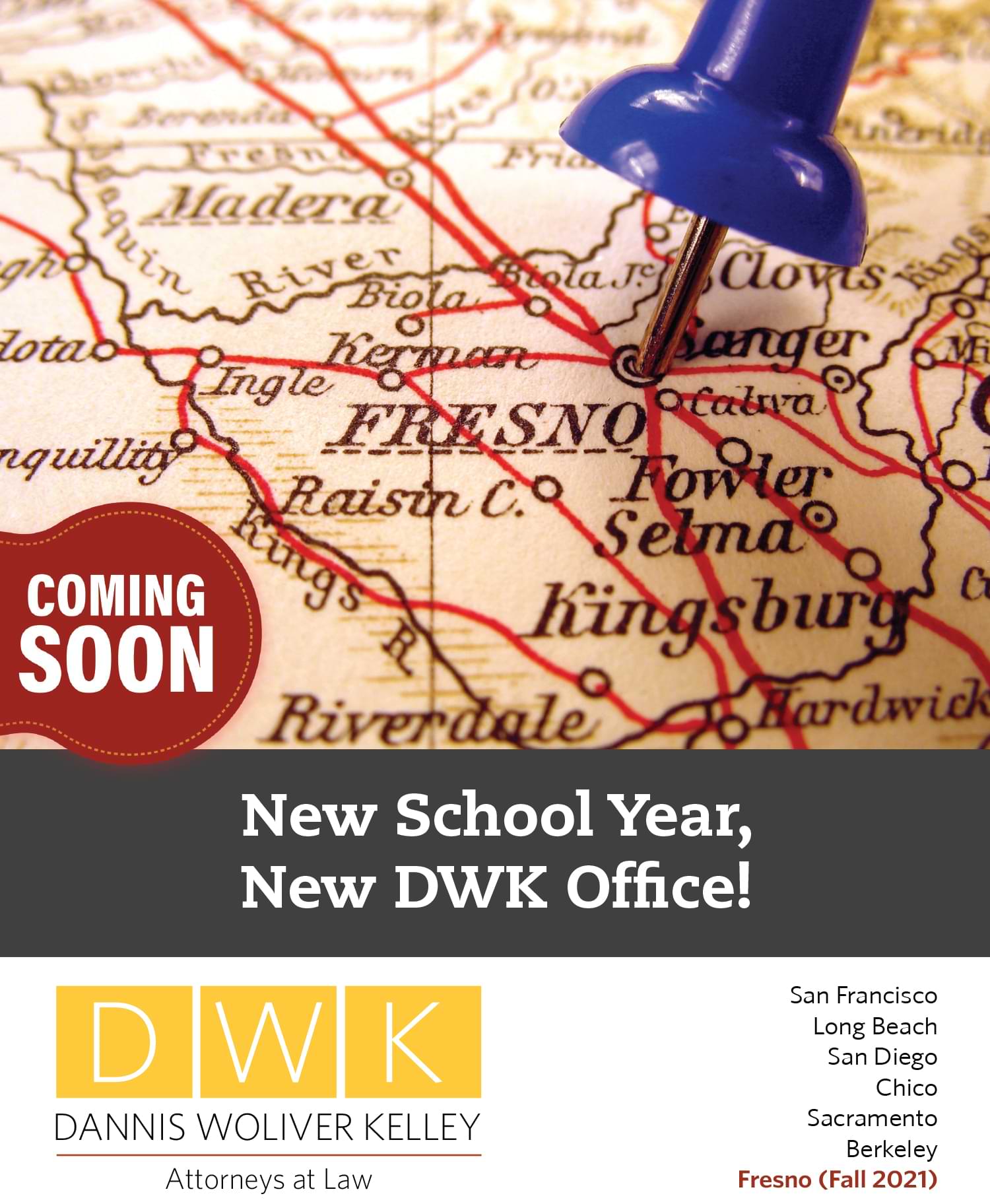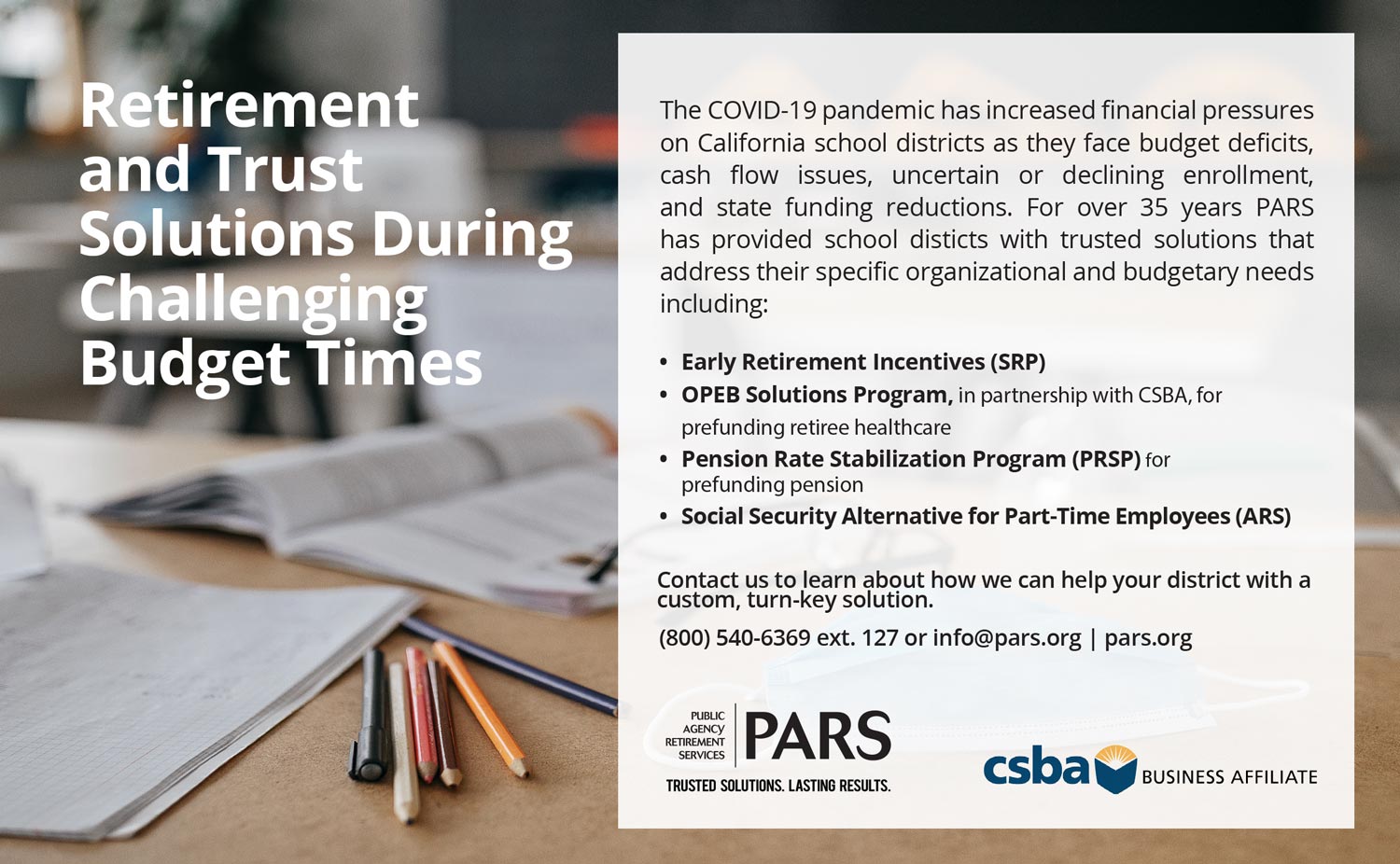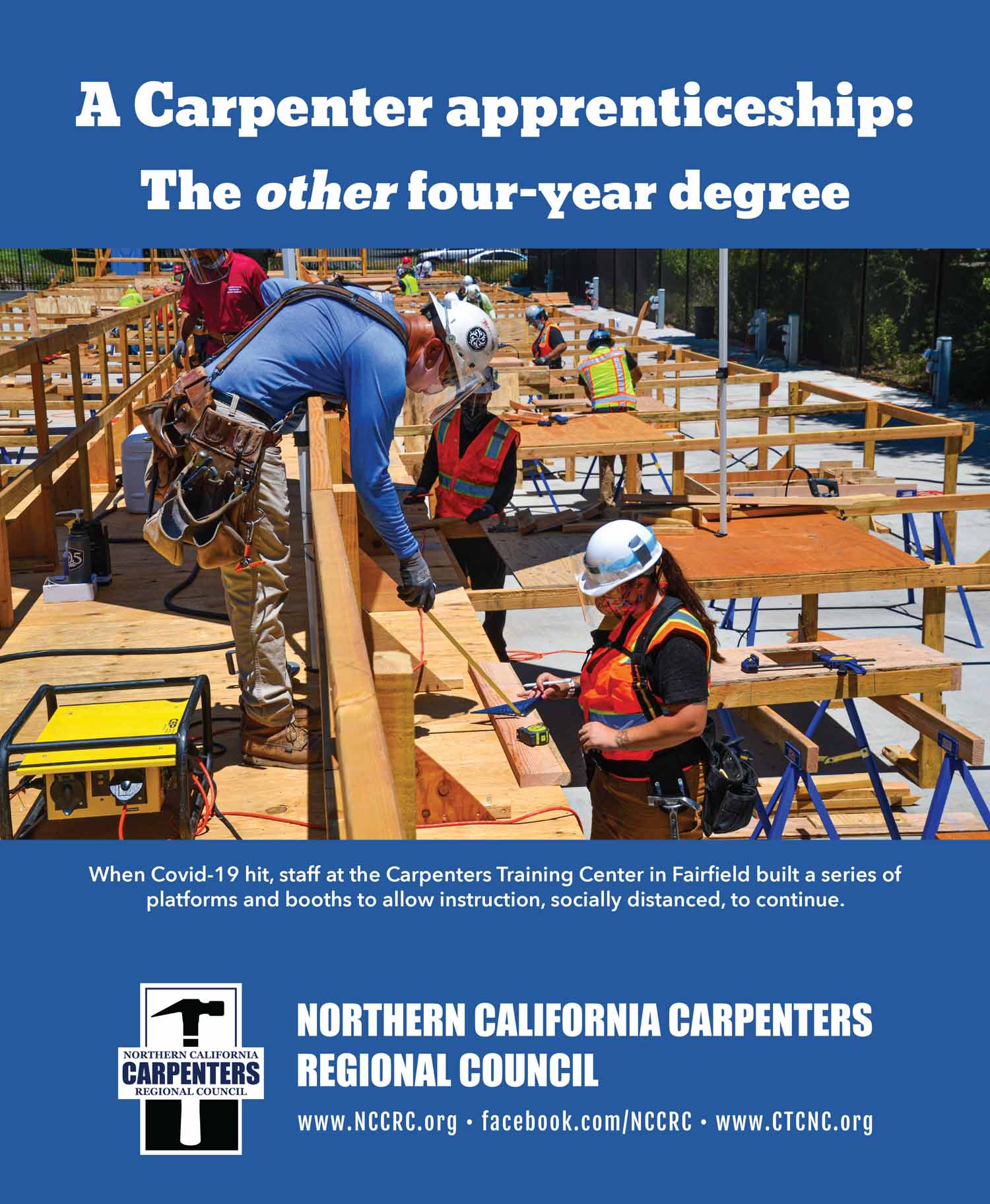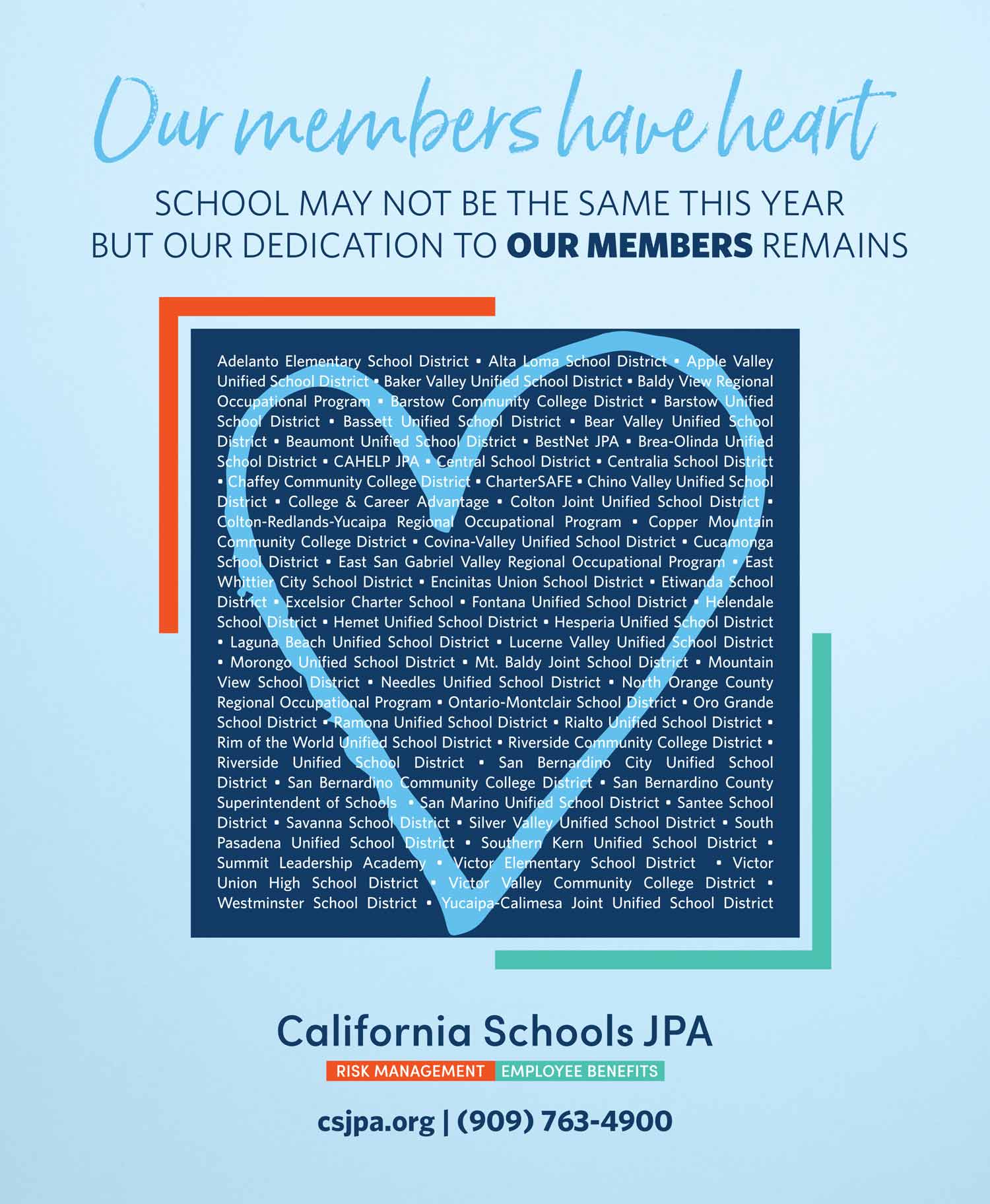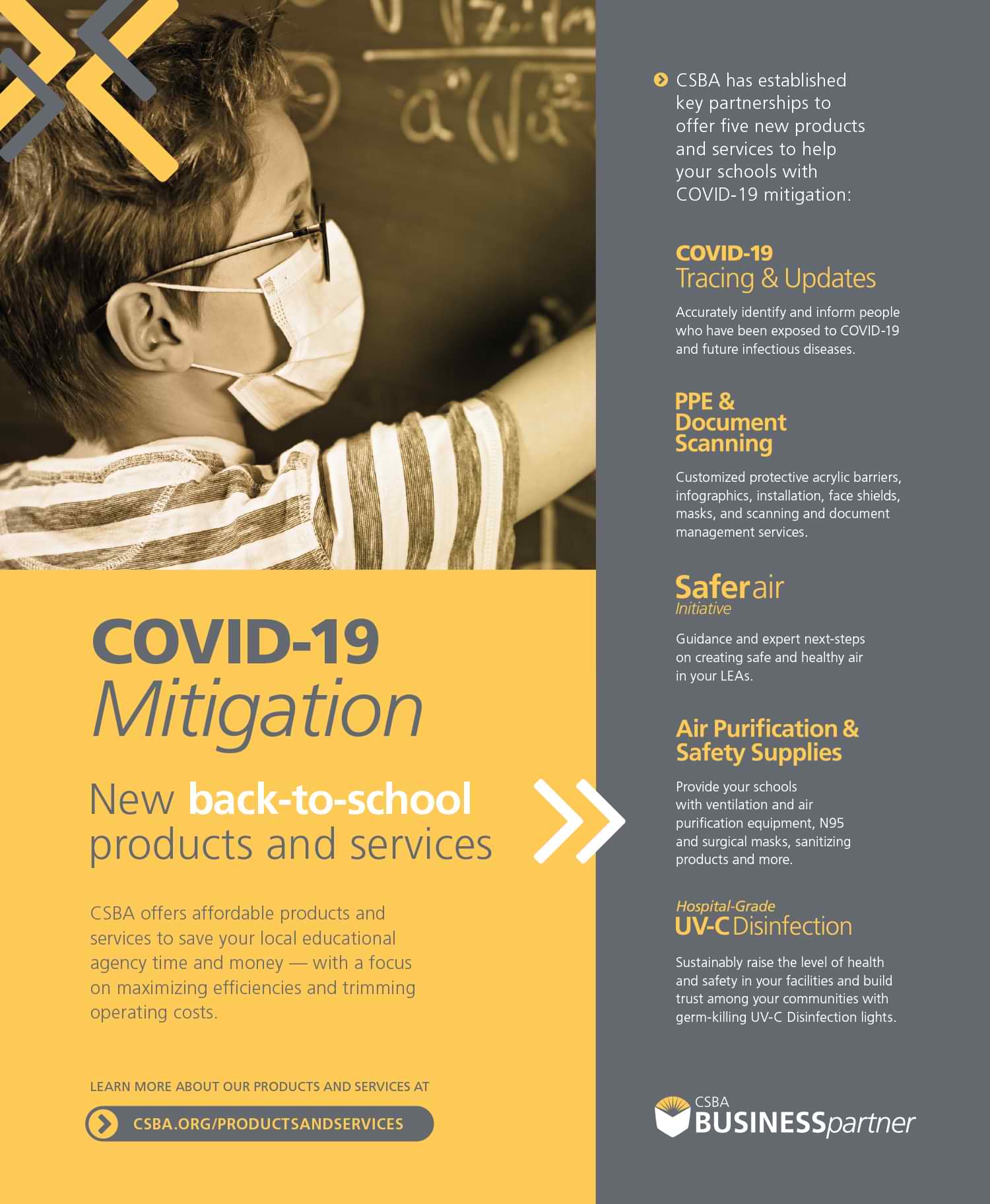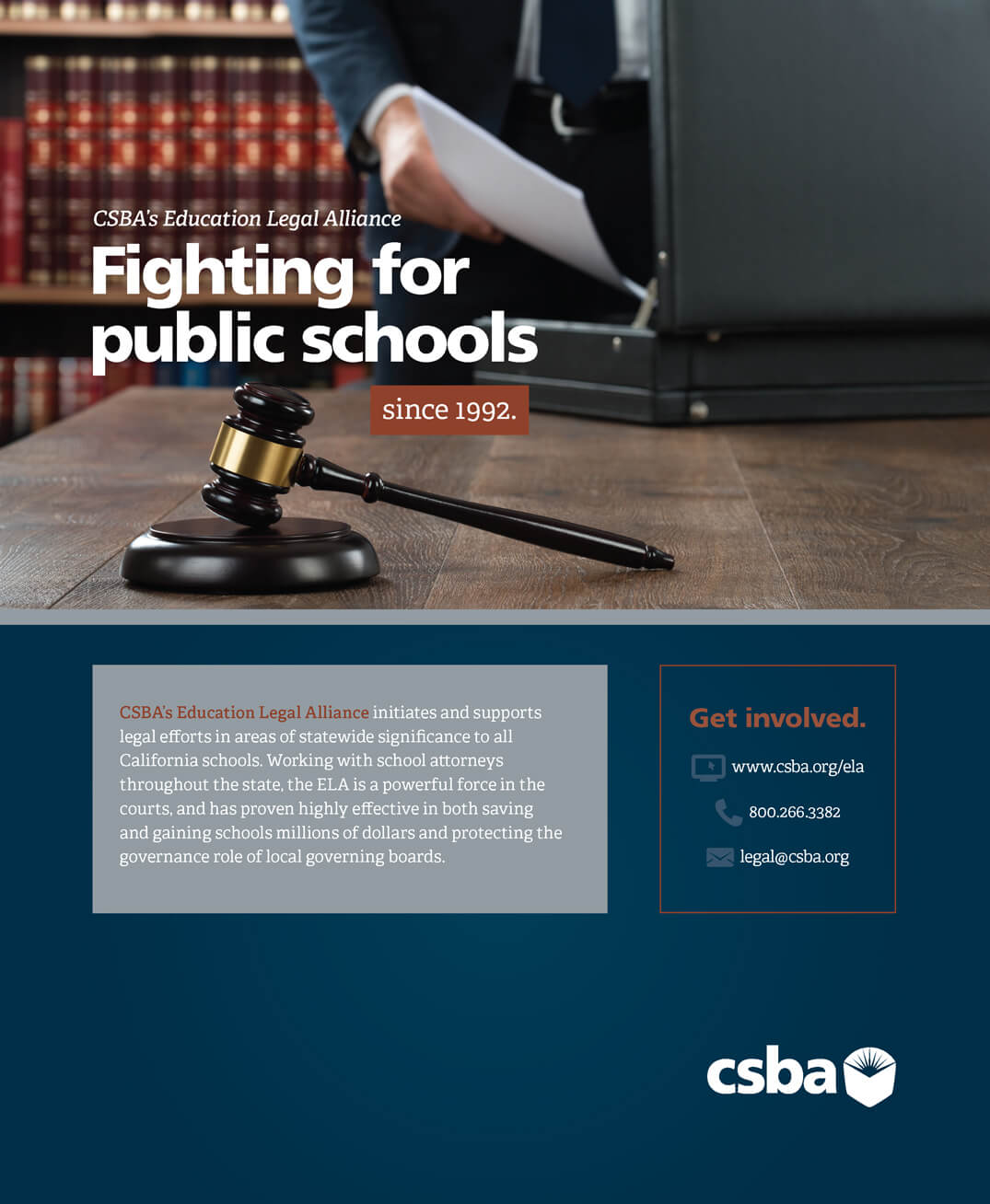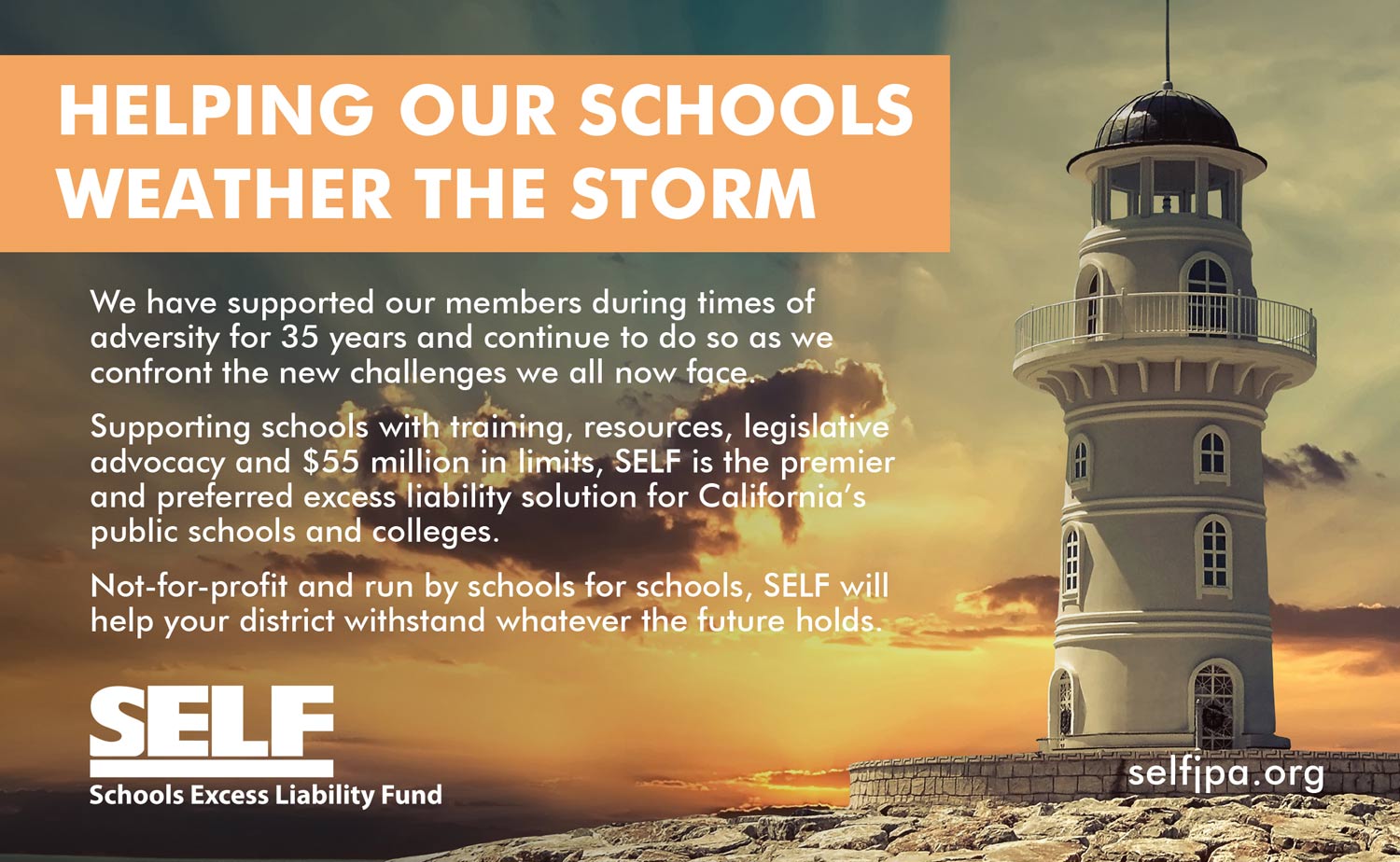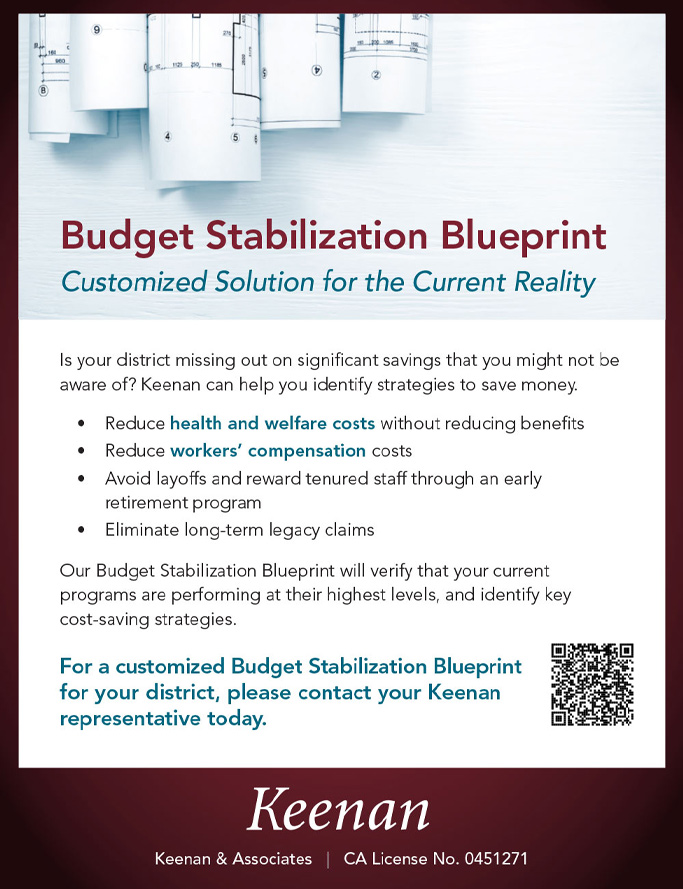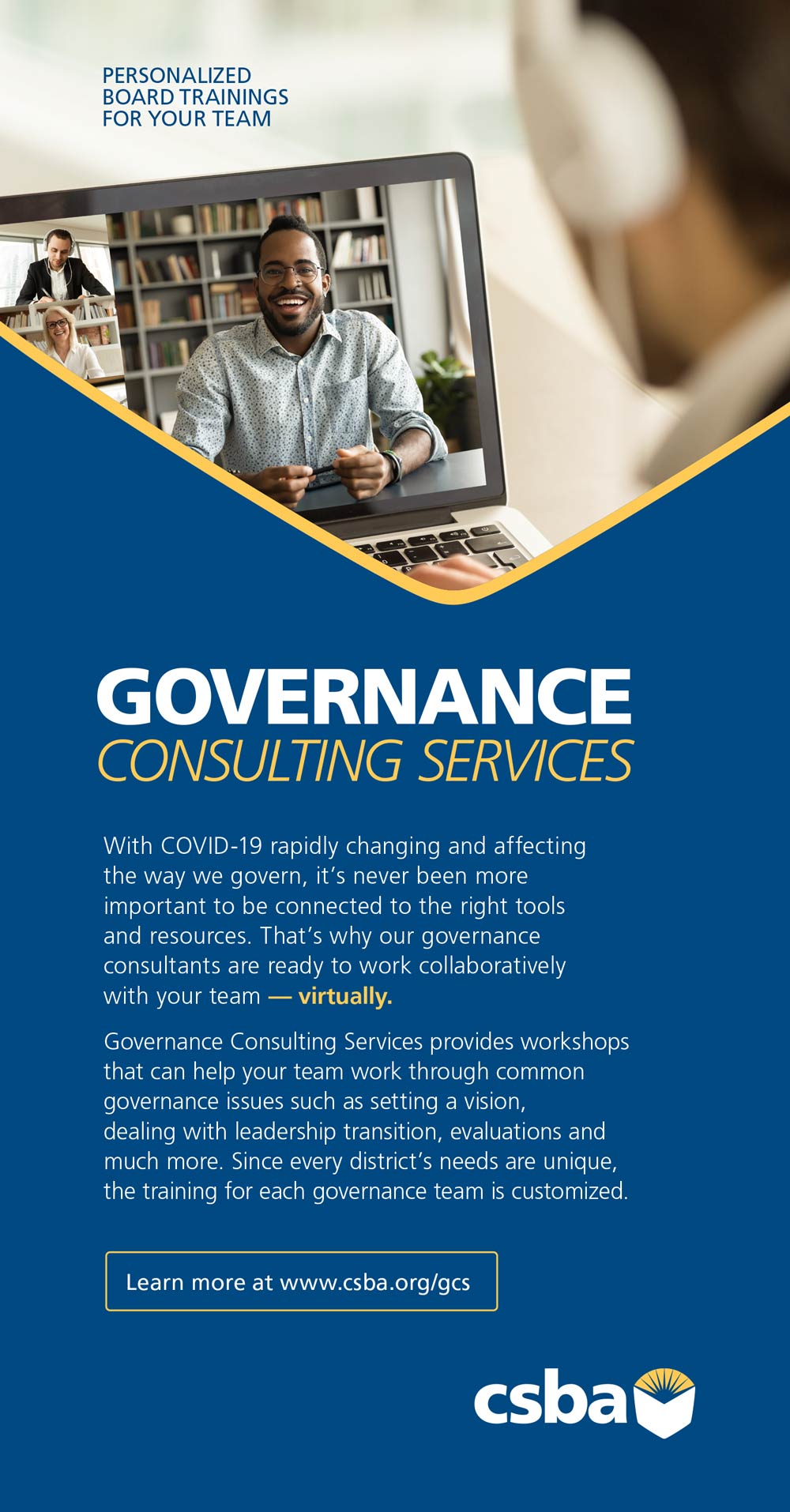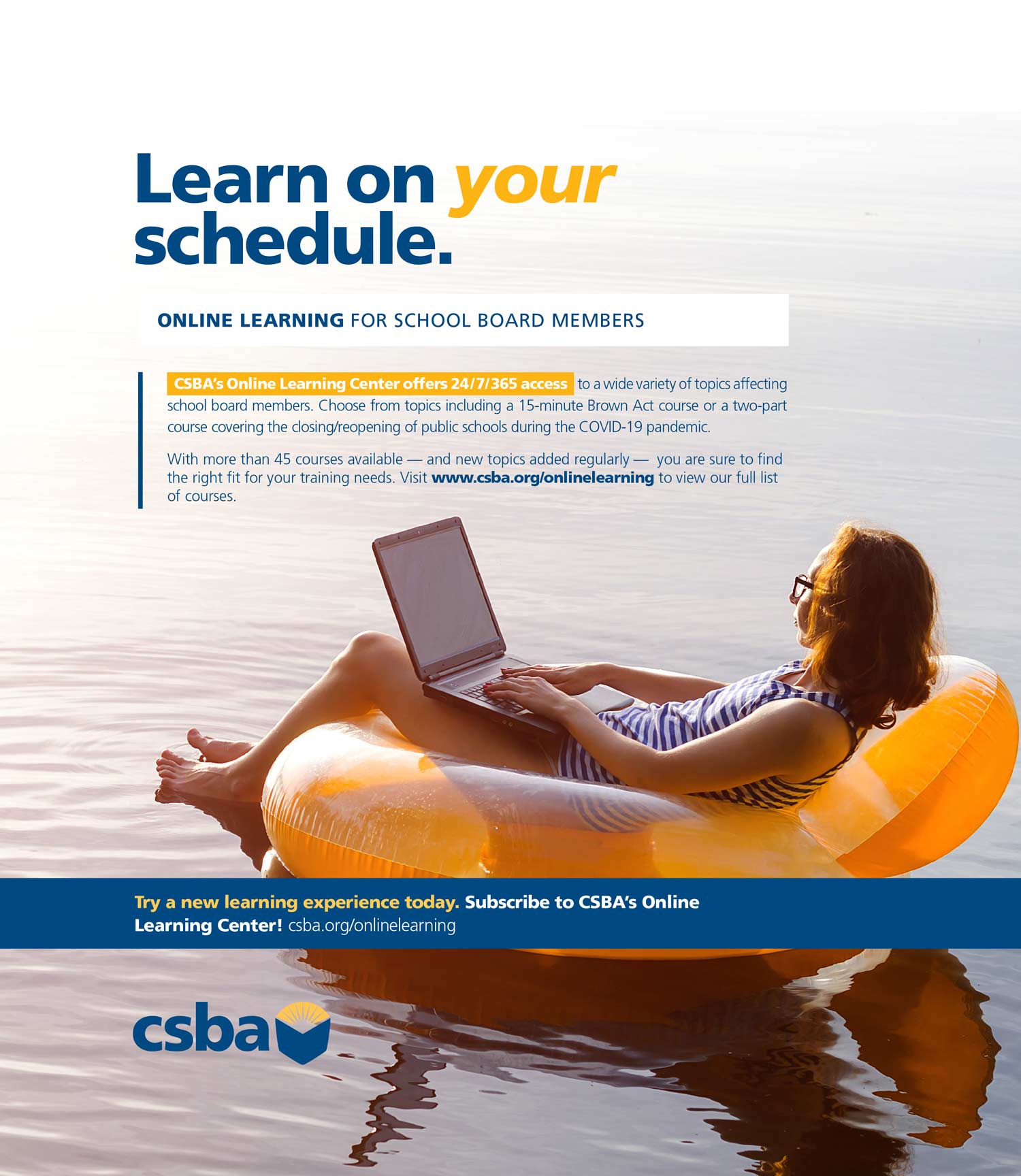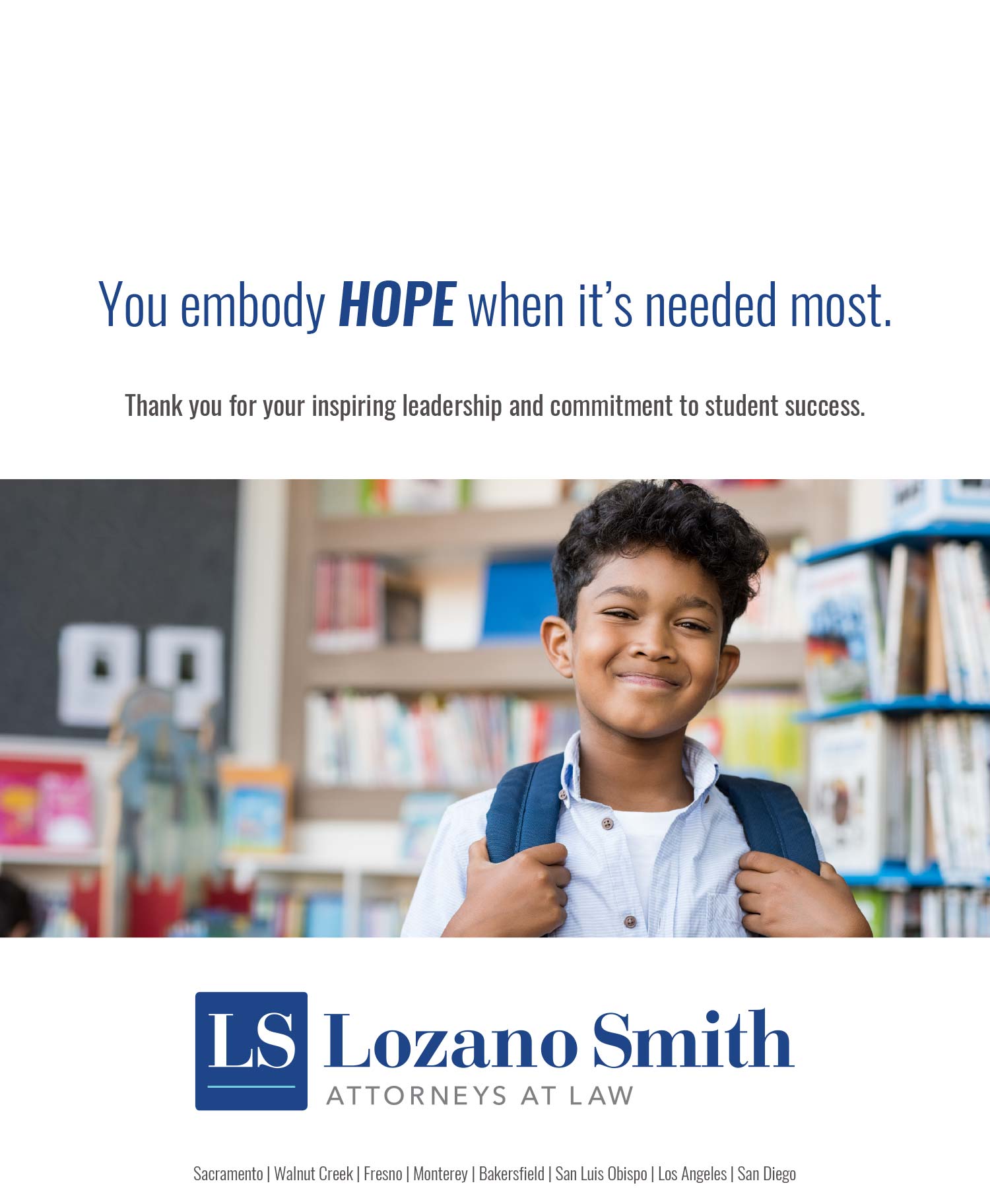
Summer 2021
Evidence-based strategies for addressing educational disruptions
by Kimberly Sellery
How declining enrollment is affecting California education
by Alisha Kirby
How schools are addressing student physical and mental health after the pandemic
by Heather Kemp
by Vernon M. Billy
by Bode Owoyele
by Luan Burman Rivera, Bina Lefkovitz and Teri Vigil
by Dale Allender, Ph.D.
Interview with Christine Chacon Kennedy
Heather Calomese, Director of the Special Education Division at the CDE
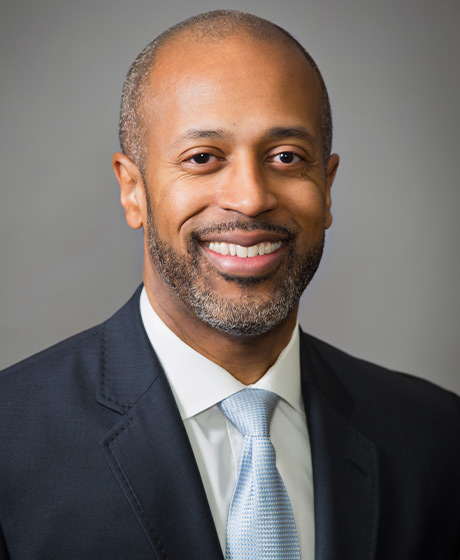
arely, if ever, has summer break been more eagerly anticipated than after the grueling school year we just completed. Yet, as with almost everything that occurs during the pandemic, there is a catch.
Across California, school districts and county offices of education are shattering enrollment records for summer school while simultaneously preparing for full-time classroom instruction in the fall. Transitioning from hybrid instruction to robust summer schools with expanded learning and social support opportunities is challenging. Doing it while concurrently laying the foundation for a 2021–22 school year that will require more interventions and greater student support than any in memory is an especially delicate balancing act.

Region 1, Del Norte County USD
Sherry Crawford
Region 2, Siskiyou COE
A.C. “Tony” Ubalde, Jr.
Region 3, Vallejo City USD
Renee Nash
Region 4, Eureka Union SD
Alisa MacAvoy
Region 5, Redwood City ESD
Darrel Woo
Region 6, Sacramento City USD
Yolanda Peña Mendrek
Region 7, Liberty Union HSD
Region 8, Manteca USD
Tami Gunther
Region 9, Atascadero USD
Kathy Spate
Region 10, Caruthers USD
Sabrena Rodriguez
Region 11, Ventura USD
William Farris
Region 12, Sierra Sands USD
Meg Cutuli
Region 15, Los Alamitos USD
Karen Gray
Region 16, Silver Valley USD
Region 17, Solana Beach SD
Wendy Jonathan
Region 18, Desert Sands USD
Albert Gonzalez
Region 20, Santa Clara USD
Scott Schmerelson
Region 21, Los Angeles USD
Nancy Smith
Region 22, Palmdale SD
Helen Hall
Region 23, Walnut Valley USD
Leighton Anderson
Region 24, Whittier Union HSD
Director-at-Large African American,
Monterey Peninsula USD
Crystal Martinez-Alire
Director-at-Large American Indian,
Elk Grove USD
Amy Koo
Director-at-Large Asian/Pacific Islander,
Belmont-Redwood Shores SD
Bruce Dennis
Director-at-Large County, Riverside COE
Joaquín Rivera
Director-at-Large Hispanic, Alameda COE
Rick Shea
CCBE President, San Diego COE
Region 1, Del Norte County USD
Sherry Crawford
Region 2, Siskiyou COE
A.C. “Tony” Ubalde, Jr.
Region 3, Vallejo City USD
Renee Nash
Region 4, Eureka Union SD
Alisa MacAvoy
Region 5, Redwood City ESD
Darrel Woo
Region 6, Sacramento City USD
Yolanda Peña Mendrek
Region 7, Liberty Union HSD
Stephen J. Schluer
Region 8, Manteca USD
Tami Gunther
Region 9, Atascadero USD
Kathy Spate
Region 10, Caruthers USD
Sabrena Rodriguez
Region 11, Ventura USD
William Farris
Region 12, Sierra Sands USD
Meg Cutuli
Region 15, Los Alamitos USD
Karen Gray
Region 16, Silver Valley USD
Debra Schade
Region 17, Solana Beach SD
Wendy Jonathan
Region 18, Desert Sands USD
Albert Gonzalez
Region 20, Santa Clara USD
Scott Schmerelson
Region 21, Los Angeles USD
Nancy Smith
Region 22, Palmdale SD
Helen Hall
Region 23, Walnut Valley USD
Leighton Anderson
Region 24, Whittier Union HSD
Bettye Lusk
Director-at-Large African American,
Monterey Peninsula USD
Crystal Martinez-Alire
Director-at-Large American Indian,
Elk Grove USD
Amy Koo
Director-at-Large Asian/Pacific Islander,
Belmont-Redwood Shores SD
Bruce Dennis
Director-at-Large County, Riverside COE
Joaquín Rivera
Director-at-Large Hispanic, Alameda COE
Rick Shea
CCBE President, San Diego COE

legal insights
“Meeting” under the Brown Act
very few years, it becomes necessary to clarify certain aspects of the Brown Act, California’s open meetings law applicable to school district and county boards of education. The clarification is almost always due to the turnover of trustees after an election and to new situations to which the Act may apply. With more than 950 new trustees elected in 2020 and the virtual meeting experience forced upon boards by the COVID-19 outbreak, these twin factors are currently at play.

Chief Information Officer
Troy Flint, tflint@csba.org
Managing Editor
Kimberly Sellery, ksellery@csba.org
Staff Writers
Heather Kemp, hkemp@csba.org
Alisha Kirby, akirby@csba.org
Graphic Design Manager
Kerry Macklin, kmacklin@csba.org
Senior Graphic Designer
Mauricio Miranda, mmiranda@csba.org
Circulation and Advertising
csba@csba.org
CSBA OFFICERS
Dr. Susan Heredia, Natomas USD
President-elect
Vacant
Vice President
Susan Markarian, Pacific Union ESD
Immediate Past President
Xilonin Cruz-Gonzalez, Azusa USD
CEO & Executive Director
Vernon M. Billy
Articles submitted to California Schools are edited for style, content and space prior to publication. Views expressed are those of the authors and do not necessarily represent CSBA policies or positions. Articles may not be reproduced without written permission of the publisher. Endorsement by CSBA of products and services advertised in California Schools is not implied or expressed.

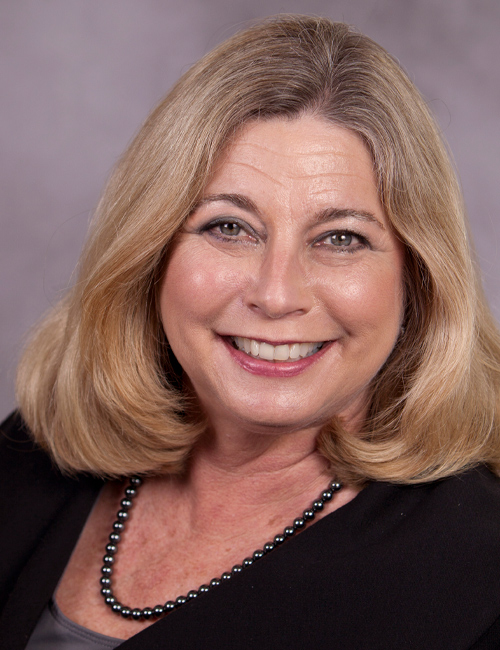
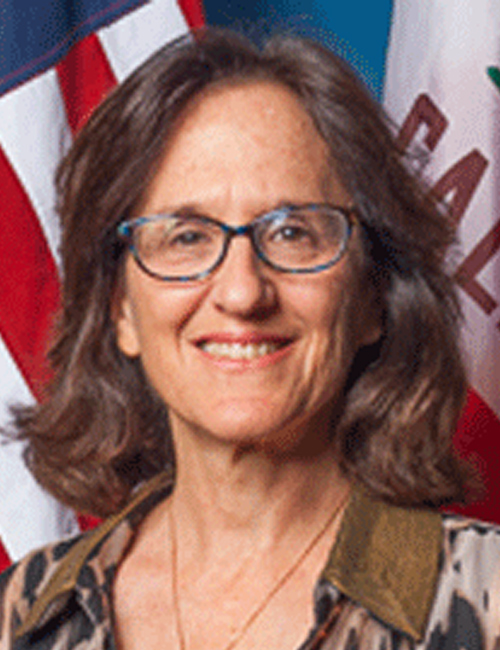
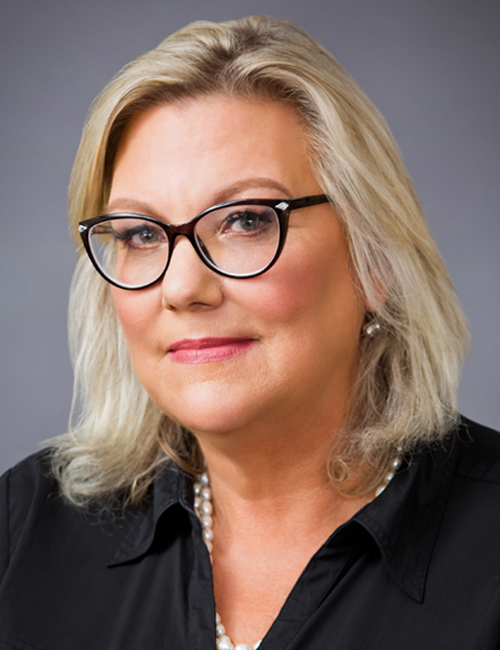
How does professional development grow the leadership of the board?
class act Best practices in action
Best practices in action

Best practices in action

“It is a program that provides rich opportunities for students to develop literacy skills with a STEM [science, technology, engineering and math] connection,” Clendineng said. “During this fun and engaging program, students participate in hands-on lessons that integrate rigorous and high-interest literacy activities, science and technology. As part of these units of study, students receive targeted instruction in reading comprehension and writing skills as well as opportunities to participate in inquiry-based science and engineering tasks.”
he digital divide, or the gap between those who have access to the internet and those who do not, isn’t new — but with the pandemic and widespread school closures came an acknowledgment that the problem needed to be resolved as quickly as possible or students would be left behind.
In a poll commissioned last fall by the Education Trust-West, 38 percent of low-income families and 29 percent of families of color said they were concerned about distance learning because they lack reliable internet at home. In rural areas, only one-third of California households are subscribed to internet service, according to an EdSource analysis of data from the California Public Utilities Commission. And even in urban areas that have access to the internet, network speeds are frequently too slow to make distance learning practical, and the more expensive internet plans simply aren’t feasible for many families.
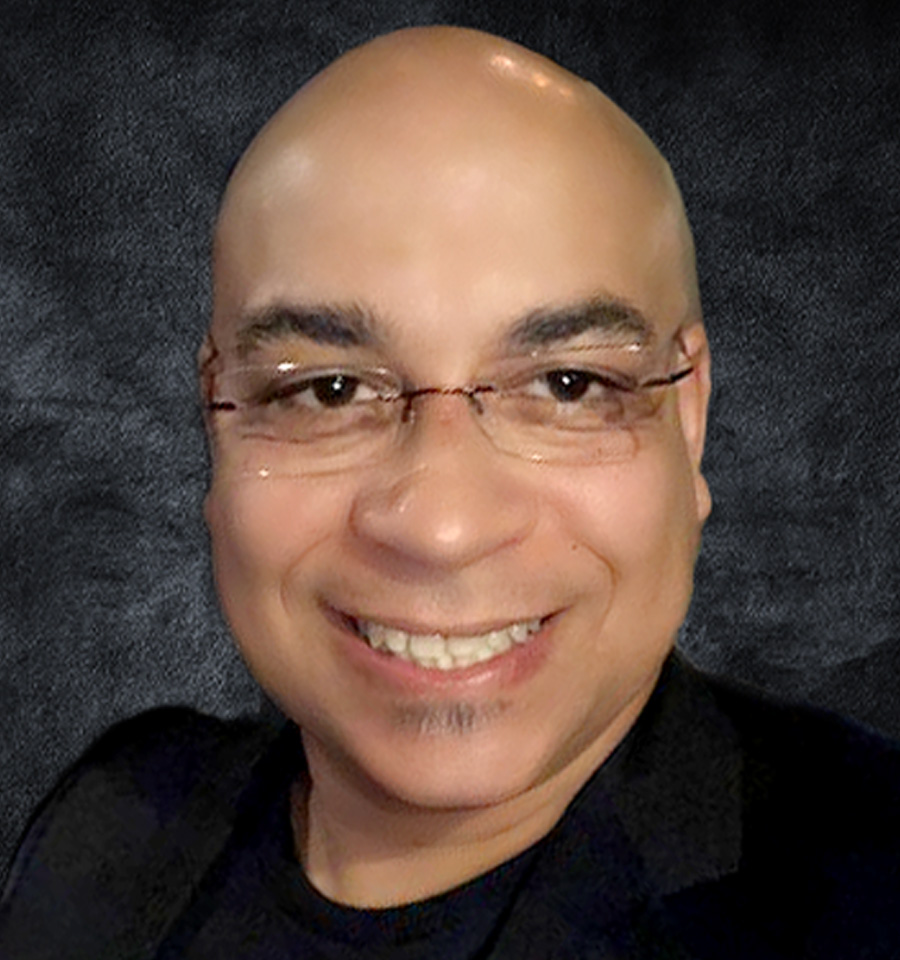
fter four years, more than 100,000 public comments and three field reviews, the California State Board of Education adopted the Ethnic Studies Model Curriculum on March 18, 2021. For districts looking to create and support ethnic studies courses, teacher professional development will be an important element in implementation.
Californians have been advocating for ethnic studies at institutional, district and state levels for more than 50 years. More recently, school boards around the state, led by board members such as Rosie Torres in Oakland, AngelAnn Flores in Stockton, and Darrel Woo of Sacramento have been reviewing and passing resolutions supporting ethnic studies and in some cases adding ethnic studies courses as requirements or electives.
And with good reason: research has documented academic and social value for all students taking ethnic studies classes.
How long have you been a board member and what inspired you to run for the position?
I have been a board member since 2003. My inspiration to run for the board was derived from my involvement in the Parent Teacher Association. By 2003, I had been involved with PTA and had attended board meetings for years. Through my involvement, I was able to see how I could make a difference on the board. When there was a vacancy that needed to be filled in December 2003, I applied and was appointed that month.
Who inspired you growing up?
My biggest inspiration growing up was my Dad. He was always very civic minded and instilled in me a strong sense of responsibility and duty to be an active part of my community. Additionally, he had a strong work ethic and always said “you have to work as hard as you can for as long as you can because there is going to come a day when you can’t work.” I still live by those words.
What is one thing you are particularly proud of your board accomplishing over the last year?
Obviously, the last year was unlike anything any district has ever had to go through. However, I am extremely proud of how we were able to lead the way and implement a cohesive, safe and effective learning plan for all our K-8 students. Our board was able to work collaboratively with the teachers, community and parents to ensure that our families were always informed, and our kids were always safe and had access to all the tools they needed to learn from home.
What advice do you have for new and aspiring board members?
First, if you feel compelled to run and give back to our educational community, I urge you to act on those feelings. Second, remember that at this level, you have the ability to make serious change in a young person’s life, so always take your role seriously. And lastly, never forget why you are in this role, and remember it’s always about the kids!
Why did you feel it was so important to get students back into classrooms?
It was important for the mental health of our students. They need to be among their peers and socialize — not isolated in their rooms. Additionally, we didn’t want our kids to fall behind due to circumstances in their homes where parents had to work or could not help them with their studies. Another concern was for students who had parents that could not stay home to make sure they went to virtual class and that many parents did not or could not help. We just could not let our students fall behind like that.
What books or authors have left a lasting impression on you?
I have read two books by Jamie Ford; Hotel on the Corner of Bitter and Sweet and Love and other Consolation Prizes and enjoyed them both immensely. Both books really gave me insight of just what some people had to endure to survive. I also read I Have Been Waiting for You by Father Larry Gosselin, and it’s about Father Larry’s personal relationship with Saint Teresa of Kolkata. It was a very spiritual and rewarding book to read that has definitely left a lifelong impression on how I try to live my life.
What is one major concern you hope to address as a board member?
With our constantly changing world and subsequent constant updates to how we learn and interact with others, I hope to continue efforts to make sure all students in our district have access to the latest technology, that classrooms are equipped with the proper facilities to create a healthy and comfortable learning environment for all, and that teachers have all the resources and training needed to ensure the complete success of our kids.

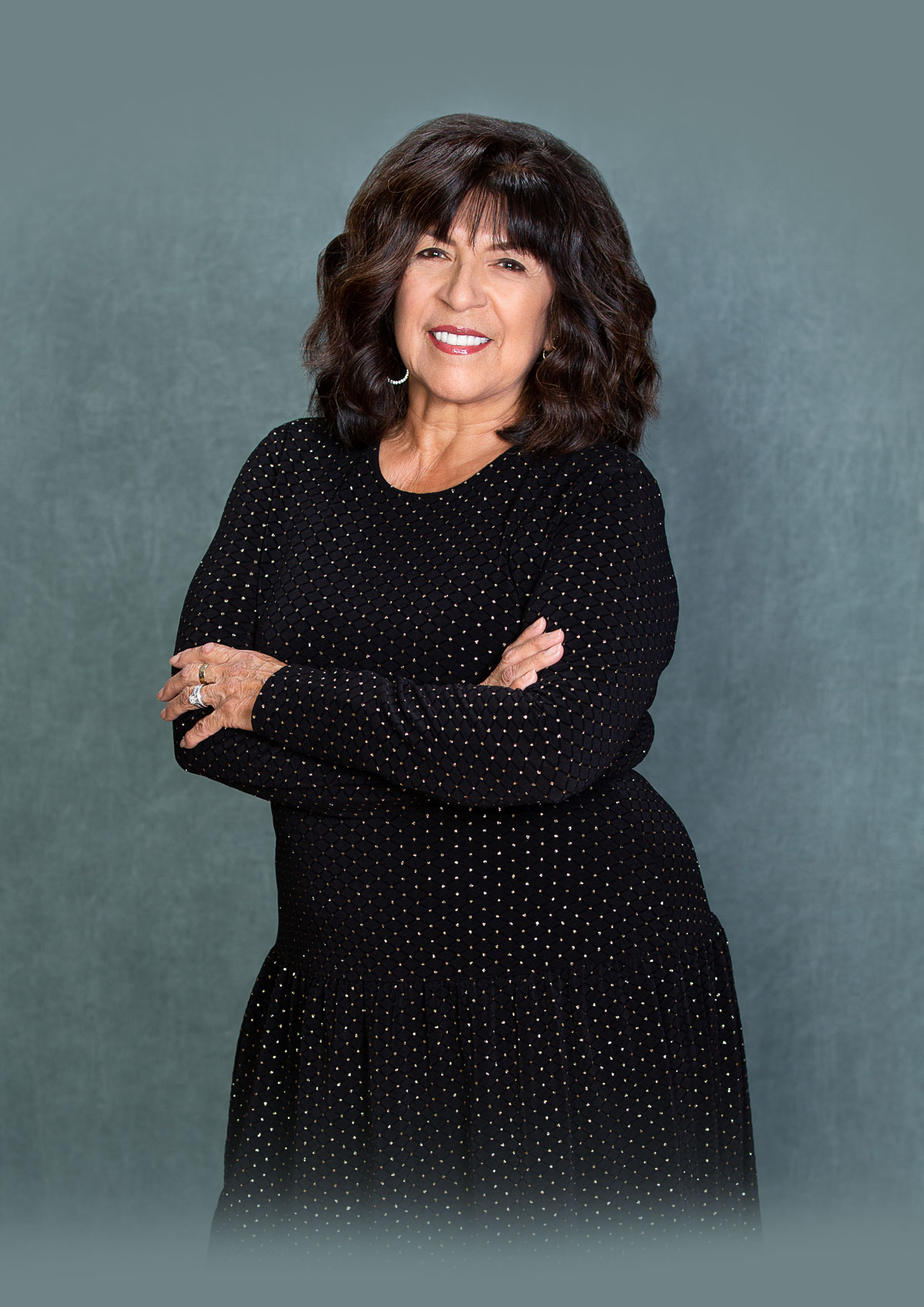
How long have you been a board member and what inspired you to run for the position?
I have been a board member since 2003. My inspiration to run for the board was derived from my involvement in the Parent Teacher Association. By 2003, I had been involved with PTA and had attended board meetings for years. Through my involvement, I was able to see how I could make a difference on the board. When there was a vacancy that needed to be filled in December 2003, I applied and was appointed that month.
Who inspired you growing up?
My biggest inspiration growing up was my Dad. He was always very civic minded and instilled in me a strong sense of responsibility and duty to be an active part of my community. Additionally, he had a strong work ethic and always said “you have to work as hard as you can for as long as you can because there is going to come a day when you can’t work.” I still live by those words.
What is one thing you are particularly proud of your board accomplishing over the last year?
Obviously, the last year was unlike anything any district has ever had to go through. However, I am extremely proud of how we were able to lead the way and implement a cohesive, safe and effective learning plan for all our K-8 students. Our board was able to work collaboratively with the teachers, community and parents to ensure that our families were always informed, and our kids were always safe and had access to all the tools they needed to learn from home.
What advice do you have for new and aspiring board members?
First, if you feel compelled to run and give back to our educational community, I urge you to act on those feelings. Second, remember that at this level, you have the ability to make serious change in a young person’s life, so always take your role seriously. And lastly, never forget why you are in this role, and remember it’s always about the kids!
Why did you feel it was so important to get students back into classrooms?
It was important for the mental health of our students. They need to be among their peers and socialize — not isolated in their rooms. Additionally, we didn’t want our kids to fall behind due to circumstances in their homes where parents had to work or could not help them with their studies. Another concern was for students who had parents that could not stay home to make sure they went to virtual class and that many parents did not or could not help. We just could not let our students fall behind like that.
What books or authors have left a lasting impression on you?
I have read two books by Jamie Ford; Hotel on the Corner of Bitter and Sweet and Love and other Consolation Prizes and enjoyed them both immensely. Both books really gave me insight of just what some people had to endure to survive. I also read I Have Been Waiting for You by Father Larry Gosselin, and it’s about Father Larry’s personal relationship with Saint Teresa of Kolkata. It was a very spiritual and rewarding book to read that has definitely left a lifelong impression on how I try to live my life.
What is one major concern you hope to address as a board member?
With our constantly changing world and subsequent constant updates to how we learn and interact with others, I hope to continue efforts to make sure all students in our district have access to the latest technology, that classrooms are equipped with the proper facilities to create a healthy and comfortable learning environment for all, and that teachers have all the resources and training needed to ensure the complete success of our kids.

isnʼt Lost

myriad effects of the pandemic and learning online have created new hardships for nearly every student and has only exacerbated longstanding opportunity and achievement gaps — both in school and in the community — experienced by low-income students, students of color, English learners and students with disabilities. In December 2020, the education research organization NWEA released a report tracking students’ growth in grades 3–8 by comparing how they performed on MAP (Measure of Academic Progress) Growth assessments compared to students in fall 2019. The results found that, on average, students performed 5 to 10 percentile points lower in math, but about the same in reading. However, other studies have found that teachers and other education experts are concerned that very young learners have not mastered the foundational reading skills as they would have in the classroom.

enrollment is affecting
California education

here is no doubt the pandemic profoundly disrupted schooling nationwide. Despite the best efforts of governance teams, teachers, parents and policymakers, experts have raised serious concerns about the impact of remote instruction on children’s learning, existing inequities, students’ mental and social-emotional health and more — and that’s among students who were enrolled in school during the 2020–21 and 2021–22 academic years.
Faced with the prospect of online kindergarten, many families opted to forego it altogether or, for those with the means and ability, find an in-person alternative to their local public school’s offerings.

Student
Checkup

Student
Checkup
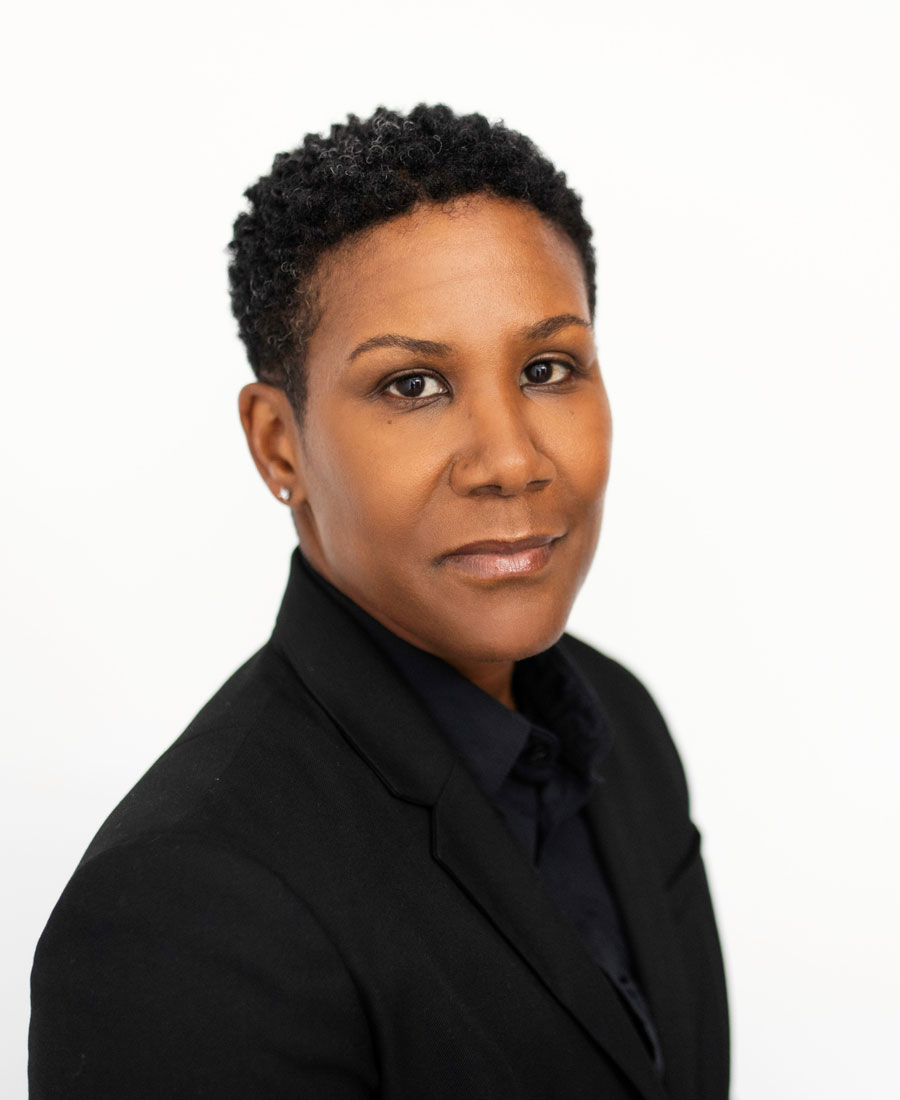
I came to the field of education as a career-changer, if you will. I was a journalist, I was an editor and a reporter. I was able to get my master’s degree in special education through an alternative certification program, in terms of people transitioning from careers into education, and really start teaching alongside of that. Actually, I was a paraprofessional at the time, then I was a special ed teacher, special ed administrator, so on and so forth. And so, I think for me, having been someone that really enjoyed being in the classroom, that really has been something that drives me, even to this day, in terms of really ensuring that our students receive the best, highest-quality supports possible. And really looking at and examining issues from a teacher’s lens or teacher’s perspective at times as well.


